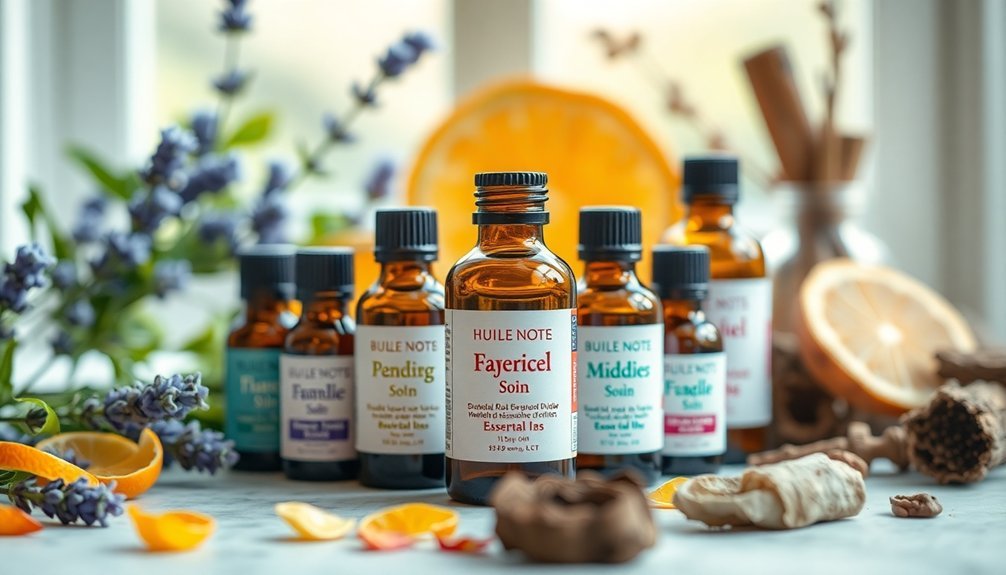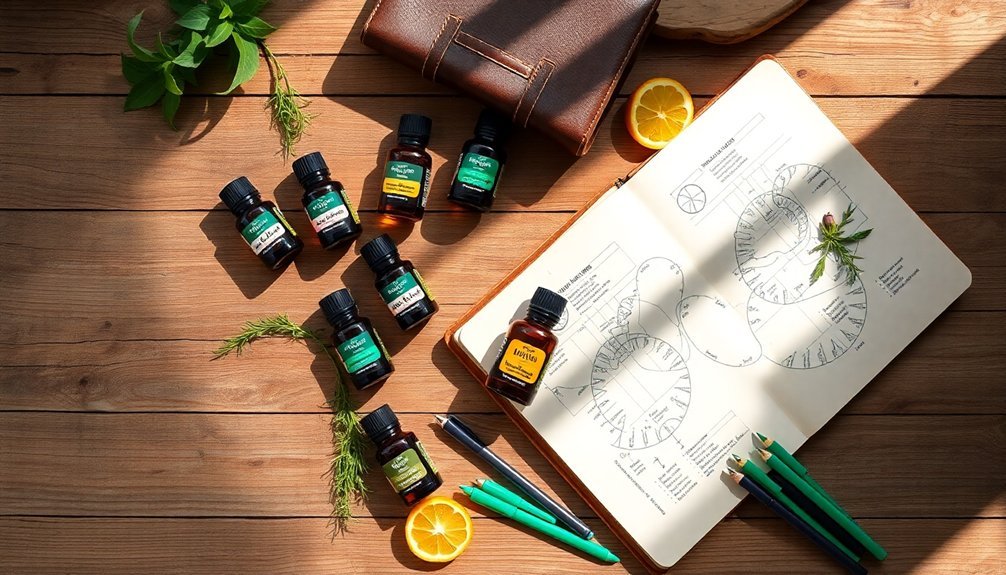Map your essential oil notes effectively by understanding the three-layer pyramid system: top notes like citrus for initial impact, middle notes like florals for the heart, and base notes like vanilla for foundation. You'll want to follow the 30/50/20 blending rule to balance your ratios, with 30% top, 50% middle, and 20% base notes. Test your blends on paper strips and skin while documenting scent changes over time – there's much more to discover about creating harmonious fragrances.
Understanding the Essential Oil Notes Pyramid

When blending essential oils, understanding the notes pyramid is crucial for creating balanced and long-lasting fragrances. The pyramid consists of three distinct layers that work together to create a harmonious scent experience. Testing on skin helps determine how the fragrance interacts with your body chemistry.
You'll first encounter the top notes, which provide the initial impression with light, fresh scents like citrus and mint. These volatile notes last up to two hours before fading.
The middle notes emerge within 20 minutes, forming the heart of your blend with floral and spicy aromas that can last several hours.
Finally, the base notes appear after 30 minutes, providing a deep, lasting foundation with rich scents like vanilla and sandalwood. These heavy notes ground your blend and can persist for days, ensuring a smooth shift between layers as the fragrance evolves.
Mastering the 30/50/20 Blending Rule
Building on our understanding of the notes pyramid, let's explore the practical 30/50/20 blending rule that helps create well-balanced aromatherapy compositions.
You'll want to start with 30% top notes, like bergamot or lemon, which provide the initial burst of fragrance.
Follow this with 50% middle notes, such as lavender or geranium, forming the heart of your blend. Finally, add 20% base notes, like vanilla or patchouli, for lasting power.
For a 10-drop blend, you'd use three drops of top notes, five drops of middle notes, and two drops of base notes. Understanding these fragrance note categories helps create unique and personalized combinations that reflect your style.
You can combine multiple oils within each category – for instance, splitting your top notes between orange and eucalyptus.
Just remember to maintain proper dilution with your carrier oil, using 15 drops per 30ml for safe topical application.
Testing and Documenting Your Note Maps

To master essential oil blending, you'll need a systematic approach for testing and documenting your note combinations. Start by performing organoleptic tests, smelling each oil directly from the bottle or using test strips. Record your observations about their volatility and intensity over a 30-minute period.
Create a detailed blending worksheet to track your experiments. Include the types and amounts of oils used, along with descriptive terms for their scents – whether they're mossy, fruity, floral, or green. Keep in mind that top notes evaporate quickly when documenting your observations.
Don't forget to note how each fragrance makes you feel emotionally and physically.
When testing blends, wait at least 30 minutes for the notes to settle. Use visual aids like colors or symbols to organize your information, and continuously review and adjust your ratios until you achieve your desired scent profile.
Frequently Asked Questions
Can Essential Oil Notes Change Based on Temperature and Humidity?
Yes, you'll notice your essential oil notes change considerably with temperature and humidity. They'll evaporate faster in heat, while humidity affects their potency and aromatic profile. Both factors impact top notes most noticeably.
How Do Carrier Oils Affect the Perception of Essential Oil Notes?
When you blend essential oils with carriers, they'll alter your perception of the notes. Carrier oils can dilute, enhance, or modify scents while slowing evaporation, making fragrances last longer on your skin.
Is It Possible for One Essential Oil to Shift Notes?
Yes, you'll notice that some essential oils can shift between notes. For example, you'll find lavender acting as both a top and middle note, depending on the blend and how it's used.
Do Synthetic Fragrances Follow the Same Note Classification System?
Yes, you'll find that synthetic fragrances follow the same top, middle, and base note system. Like essential oils, they're classified by their volatility and longevity, creating a similar layered fragrance experience.
Can Allergies or Medications Affect How We Perceive Essential Oil Notes?
Yes, your allergies and medications can greatly impact how you perceive essential oil notes. You'll experience altered scent perception if you're congested, and certain medications may affect your sensory responses to fragrances.
In Summary
Once you've mapped out your essential oils by notes and mastered the 30/50/20 blending ratio, you'll create more balanced and longer-lasting aromatherapy blends. Keep detailed records of your successes and failures, and don't be afraid to experiment with different combinations. Whether you're crafting perfumes or therapeutic blends, understanding these note-mapping fundamentals will transform you from a novice into a confident essential oil artist.





Leave a Reply